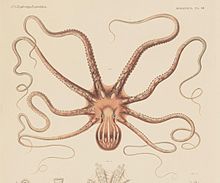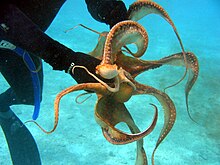77:
317:. They hunt at night and can be observed foraging over reef flats or on sand and gravel substrate during nightly low tides. Hunting consists of probing long arms down holes or enveloping small coral heads within the webs and using the arm tips to flush prey into the waiting suckers. The stomach contents also regularly contain the beaks of other octopus species. Other night-active octopuses in the same habitat flee in an explosion of ink if a single arm of this octopus touches them.
239:
33:
52:
228:
283:
oval-shaped to elongate and the eyes are large. The arms are about six times the length of the body with the front pair being the longest. Each arm has two rows of suckers. The webs are shallow. The skin is fairly smooth with long flaps able to be raised in the white stripes on the sides of the body.
296:
around the northern coastline to Perth in
Western Australia. The distribution of this octopus appears to be limited to tropical waters within the 20 °C (68 °F) isotherm. However, specimens collected in the warm temperate waters of New South Wales are probably a result of the planktonic
282:
are much longer and thicker than the other arms. They are pink to red in colour with paired white spots down the arms and short longitudinal white stripes on their mantle. This species can weigh several kilograms, and can reach an armspan of up to 2 metres (6 ft 7 in). The body is
291:
This species has one of the widest distributions of all octopus, because of the planktonic life stage of the hatchlings. It is found throughout tropical waters in the Indo-Pacific, from Hawaii and Easter Island to South Africa. In
Australian waters it is found from northern
325:
Nothing is known of mating behaviour. Females lay up to 35,000 small eggs, each about 2 millimetres (0.08 in) long. The hatchlings swim up into the plankton and are carried away by surface currents. Eventually they settle in a new coral reef and develop into adults.
334:
This octopus is harvested by subsistence hunters throughout its range. Historically it was collected by
Polynesian Hawaiians using torches to find foraging animals at night. The animals were then killed with hand spears.
305:
Adults are usually found on coral reefs. Lairs found on the southern Great
Barrier Reef consist of deep vertical holes excavated in coral rubble. The entrances are sealed during the day with rubble.
500:
Gould, A.A. 1852. United States exploring expedition during the years 1838–1842. Mollusca and Shells. U.S. Exploring
Expedition, 12: i-xv, 1-510; 1852, with an Atlas of plates, 1856.
262:
native to the Indo-Pacific region. Other common names include white-striped octopus and night octopus, in reference to its nocturnal habits. It was previously known as
794:
623:
878:
649:
848:
768:
597:
807:
873:
863:
868:
662:
812:
423:
858:
820:
701:
654:
460:
400:
Bouchet, P. (2014). Callistoctopus ornatus (Gould, 1852). Accessed through: World
Register of Marine Species at
76:
576:
571:
548:
488:
825:
706:
401:
379:
693:
799:
628:
516:
188:
553:
171:
680:
641:
853:
755:
8:
41:
197:
71:
742:
675:
584:
475:
356:
747:
589:
374:
539:
293:
733:
148:
461:
http://www.environment.gov.au/cgi-bin/species-bank/sbank-treatment.pl?id=77081
842:
636:
365:
61:
56:
563:
781:
688:
610:
138:
270:
is edible and was recorded in a
Hawaiian market in 1914 by S. S. Berry.
238:
32:
773:
602:
314:
118:
615:
786:
88:
510:
727:
533:
297:
juveniles being carried south by the warm East
Australian Current.
108:
227:
402:
http://www.marinespecies.org/aphia.php?p=taxdetails&id=534728
259:
128:
667:
760:
507:. Phuket Marine Biological Center Research Bulletin 66:127–154.
98:
354:
245:, dorsal view of a medium-sized male from Honolulu
840:
380:10.2305/IUCN.UK.2018-2.RLTS.T163200A982981.en
355:Allcock, L.; Taite, M.; Allen, G. (2018).
50:
31:
378:
237:
226:
503:Norman M.D. & Hochberg F.G. (2005)
841:
452:
450:
448:
446:
444:
418:
416:
414:
412:
410:
350:
348:
515:
514:
505:The current state of Octopus taxonomy
234:and diver, Northwest Hawaiian Islands
879:Taxa named by Augustus Addison Gould
394:
849:IUCN Red List least concern species
441:
407:
366:IUCN Red List of Threatened Species
345:
13:
313:These octopus eat mainly fish and
14:
890:
329:
75:
320:
286:
273:
1:
874:Cephalopods described in 1852
864:Molluscs of the Pacific Ocean
338:
869:Molluscs of the Indian Ocean
7:
258:) is a tropical species of
10:
895:
300:
717:
523:
203:
196:
177:
170:
72:Scientific classification
70:
48:
39:
30:
23:
859:Marine molluscs of Asia
428:australianmuseum.net.au
424:"White-striped Octopus"
308:
207:Callistoctopus arakawai
554:Callistoctopus_ornatus
525:Callistoctopus ornatus
458:www.environment.gov.au
359:Callistoctopus ornatus
280:Callistoctopus ornatus
251:Callistoctopus ornatus
246:
243:Callistoctopus ornatus
235:
232:Callistoctopus ornatus
181:Callistoctopus ornatus
25:Callistoctopus ornatus
241:
230:
373:: e.T163200A982981.
42:Conservation status
278:The upper arms of
247:
236:
16:Species of mollusc
836:
835:
676:Open Tree of Life
517:Taxon identifiers
483:Missing or empty
225:
224:
219:
211:
65:
886:
829:
828:
816:
815:
803:
802:
790:
789:
777:
776:
764:
763:
751:
750:
738:
737:
736:
710:
709:
697:
696:
684:
683:
671:
670:
658:
657:
645:
644:
632:
631:
619:
618:
606:
605:
593:
592:
580:
579:
567:
566:
557:
556:
544:
543:
542:
512:
511:
493:
492:
486:
481:
479:
471:
469:
467:
454:
439:
438:
436:
434:
420:
405:
398:
392:
391:
389:
387:
382:
352:
217:
209:
183:
80:
79:
59:
54:
53:
35:
21:
20:
894:
893:
889:
888:
887:
885:
884:
883:
839:
838:
837:
832:
824:
819:
811:
806:
798:
793:
785:
780:
772:
767:
759:
754:
746:
741:
732:
731:
726:
719:Octopus ornatus
713:
705:
700:
692:
687:
679:
674:
666:
661:
653:
648:
640:
635:
627:
622:
614:
609:
601:
596:
588:
583:
575:
570:
562:
560:
552:
547:
538:
537:
532:
519:
497:
496:
484:
482:
473:
472:
465:
463:
456:
455:
442:
432:
430:
422:
421:
408:
399:
395:
385:
383:
353:
346:
341:
332:
323:
311:
303:
294:New South Wales
289:
276:
264:Polypus ornatus
215:Octopus ornatus
192:
185:
179:
166:
163:C. ornatus
74:
66:
55:
51:
44:
17:
12:
11:
5:
892:
882:
881:
876:
871:
866:
861:
856:
851:
834:
833:
831:
830:
817:
804:
791:
778:
765:
752:
739:
723:
721:
715:
714:
712:
711:
698:
685:
672:
659:
646:
633:
620:
607:
594:
581:
568:
558:
545:
529:
527:
521:
520:
509:
508:
501:
495:
494:
440:
406:
393:
343:
342:
340:
337:
331:
328:
322:
319:
310:
307:
302:
299:
288:
285:
275:
272:
256:ornate octopus
223:
222:
221:
220:
212:
201:
200:
194:
193:
186:
175:
174:
168:
167:
160:
158:
154:
153:
150:Callistoctopus
146:
142:
141:
136:
132:
131:
126:
122:
121:
116:
112:
111:
106:
102:
101:
96:
92:
91:
86:
82:
81:
68:
67:
49:
46:
45:
40:
37:
36:
28:
27:
15:
9:
6:
4:
3:
2:
891:
880:
877:
875:
872:
870:
867:
865:
862:
860:
857:
855:
852:
850:
847:
846:
844:
827:
822:
818:
814:
809:
805:
801:
796:
792:
788:
783:
779:
775:
770:
766:
762:
757:
753:
749:
744:
740:
735:
729:
725:
724:
722:
720:
716:
708:
703:
699:
695:
690:
686:
682:
677:
673:
669:
664:
660:
656:
651:
647:
643:
638:
634:
630:
625:
621:
617:
612:
608:
604:
599:
595:
591:
586:
582:
578:
573:
569:
565:
559:
555:
550:
546:
541:
535:
531:
530:
528:
526:
522:
518:
513:
506:
502:
499:
498:
490:
477:
462:
459:
453:
451:
449:
447:
445:
429:
425:
419:
417:
415:
413:
411:
404:on 2015-02-01
403:
397:
381:
376:
372:
368:
367:
362:
360:
351:
349:
344:
336:
330:Use by humans
327:
318:
316:
306:
298:
295:
284:
281:
271:
269:
265:
261:
257:
253:
252:
244:
240:
233:
229:
216:
213:
208:
205:
204:
202:
199:
195:
190:
184:
182:
176:
173:
172:Binomial name
169:
165:
164:
159:
156:
155:
152:
151:
147:
144:
143:
140:
137:
134:
133:
130:
127:
124:
123:
120:
117:
114:
113:
110:
107:
104:
103:
100:
97:
94:
93:
90:
87:
84:
83:
78:
73:
69:
63:
58:
57:Least Concern
47:
43:
38:
34:
29:
26:
22:
19:
718:
524:
504:
485:|title=
464:. Retrieved
457:
431:. Retrieved
427:
396:
384:. Retrieved
370:
364:
358:
333:
324:
321:Reproduction
312:
304:
290:
287:Distribution
279:
277:
267:
263:
255:
250:
249:
248:
242:
231:
214:
206:
180:
178:
162:
161:
149:
24:
18:
854:Octopodidae
782:iNaturalist
689:SeaLifeBase
611:iNaturalist
386:18 February
315:crustaceans
274:Description
218:Gould, 1852
139:Octopodidae
119:Cephalopoda
843:Categories
339:References
268:C. ornatus
210:Taki, 1964
540:Q13449624
157:Species:
95:Kingdom:
89:Eukaryota
800:10215505
734:Q2742134
728:Wikidata
629:11822386
561:BioLib:
534:Wikidata
476:cite web
198:Synonyms
135:Family:
129:Octopoda
109:Mollusca
105:Phylum:
99:Animalia
85:Domain:
62:IUCN 3.1
774:2289653
603:5856009
301:Habitat
260:octopus
191:, 1852)
145:Genus:
125:Order:
115:Class:
60: (
826:342012
813:556146
761:593212
707:534728
681:711375
668:534728
655:515821
642:163200
616:121606
577:211836
564:135175
466:28 Jan
433:28 Jan
821:WoRMS
795:IRMNG
787:52312
748:48KP3
702:WoRMS
694:57248
624:IRMNG
590:5X7Z5
189:Gould
808:ITIS
769:GBIF
663:OBIS
650:NCBI
637:IUCN
598:GBIF
572:BOLD
489:help
468:2015
435:2015
388:2022
371:2018
309:Diet
756:EoL
743:CoL
585:CoL
549:AFD
375:doi
266:.
845::
823::
810::
797::
784::
771::
758::
745::
730::
704::
691::
678::
665::
652::
639::
626::
613::
600::
587::
574::
551::
536::
480::
478:}}
474:{{
443:^
426:.
409:^
369:.
363:.
347:^
491:)
487:(
470:.
437:.
390:.
377::
361:"
357:"
254:(
187:(
64:)
Text is available under the Creative Commons Attribution-ShareAlike License. Additional terms may apply.


